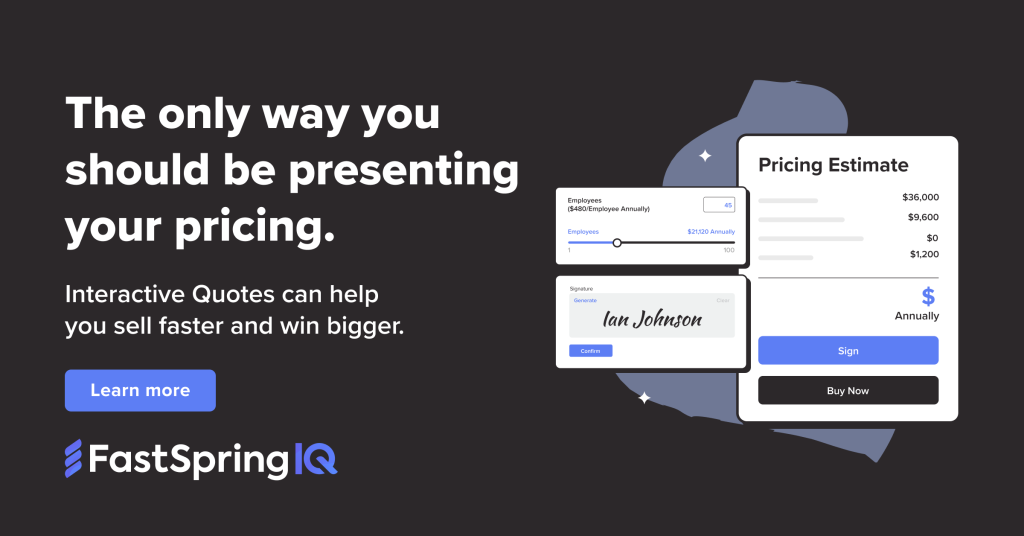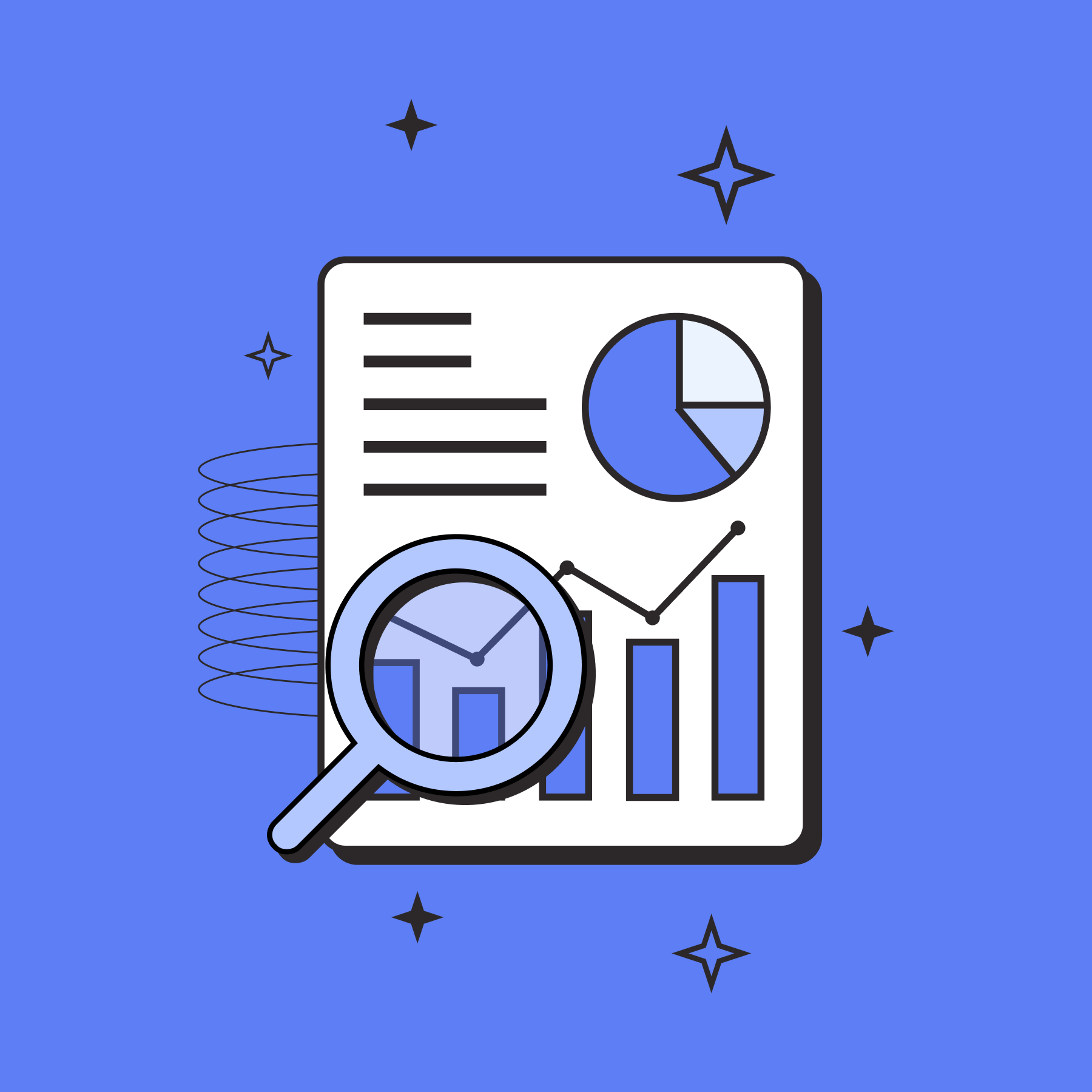The dreaded SaaS sales proposal.
Be honest—you probably dread the idea of spending hours writing out a SaaS sales proposal, tinkering with the pricing plan, trying to find just the right words to convince your buyer. There’s nothing fun about it. Plenty of salespeople feel the same way you do, and since so many drop the ball and fail to write an effective proposal, this is an opportunity to stand out and close the deal.
A great SaaS sales proposal typically comes after a client has indicated that they’re interested in a specific solution. Some organizations use straightforward templates for their proposals while others put together extensive documents that break down every detail of the deal. At FastSpring, we recognize that the legalities and best practices differ in every situation.
But you can reduce the complexity and the guesswork involved in SaaS sales proposal development by using pricing grids. A pricing grid is a sales tool that you can send to prospects before you put together a final proposal. Essentially, it allows the potential buyer to pick what they want. Once they select the price that fits their needs, the account executive is notified and can begin putting together a proposal that aligns EXACTLY with the buyer’s expectations.
In this post, we’re going to tell you, step by step, how to write SaaS sales proposals that consistently close deals faster. But before we talk about what to include in your proposal, we’ll review some of the pre-proposal preparations that need to take place.
Then we’ll dive into each section of the sales proposal:
- Cover Page
- About Us
- Problem (your prospect’s problem or challenges)
- Solution (your company’s solution)
- Case Studies & Testimonials
- Team (key executives and team members)
- Contract (e.g., terms and agreements, scope of work, etc.)
Let’s get started!
Pre-Proposal Preparations
A great sales proposal should not be a surprise.
It should feel like the next logical step in your conversations with your prospect. That’s why we strongly encourage account executives to use pricing grids before sending proposals. In addition, there are a few key questions that you’ll want to make sure you can answer before writing the proposal:
- Why does the prospect want what you’re selling? What problem is the prospect trying to solve? In order to write an effective sales proposal, you have to be clear on your prospect’s pain points and the outcomes they’re looking for. This will help you offer solutions that are tailored to your prospect’s needs.
- Are they considering any other options? If so, why are they considering those options? Understanding what your competitors are offering and how your SaaS solution differs can help you handle potential objections before they arise. And, because you’ve taken the time to understand your prospect’s pain points, you can address how your SaaS solution is better suited to meet their needs before sending your sales proposal.
- What’s their budget? It’s nearly impossible to write a proposal without knowing your client’s budget. Ideally, you would gather this information when you’re qualifying the prospect. If you don’t know their budget, ask. Don’t move forward with writing the proposal until you have an answer. Then, you can also disqualify prospects that aren’t a good fit.
- Who signs the proposal? Who is the ultimate decision-maker? As you talk with your prospect, find out who the key decision-makers are and who ultimately will sign the deal. This will help you ensure that you’re communicating with all the parties required to close the deal.
- What is the procurement process? Some organizations such as government or educational institutions have a formal procurement process to suit their complex environments, while other companies may have less formal processes for acquiring new goods or services. Understanding your prospect’s internal procurement process will help you take the proper steps to close the deal—for example, including all the information they need right there in the proposal, such as ROI analysis, project plans, timelines, legal stipulations, etc. If your proposal contains all the pieces they need in order to sign off, you’ll be that much closer to closing the deal.
Drafting Your Proposal
Once you’ve answered all these questions in the pre-proposal stage, you’re ready to start writing! A few tips before you start:
- Keep your proposal to 1–2 pages. The typical executive or other decision-maker is extremely busy and may also have a short attention span. Keep it brief.
- Use simple language. Cut jargon that people might not understand. Simplicity is your friend when it comes to writing your sales proposal.
As a reminder, here are 8 common sections of a winning SaaS sales proposal:
- Cover Page
- About Us
- Problem (your prospect’s problem or challenges)
- Solution (your company’s solution)
- Case Studies / Testimonials
- Team (key executives and team members on your team)
- Contract (e.g., terms and agreements, scope of work, etc.)
Keep in the mind that this outline isn’t written in stone. Instead, think of it as a general guideline that you can use as a starting point and adjust as you see fit.
- What Goes Into A Proposal Cover Page?
The cover page should include the name of the proposal, the client’s name, the proposal delivery date, and the submitter’s name (you). You can personalize the cover page by adding the client’s logo as well.
Although this step may seem like a no-brainer, it’s often missed. Adding a cover page to your sales proposal will give it a more polished and professional look.
First impressions matter!

Key Takeaways:
- Address your proposal to the right person.
- Keep it clean and professional.
- About Us
Your “About Us” section is an opportunity to briefly introduce your company and convince the prospect that your SaaS product will deliver the results they’re looking for.
Describing your workflow, current client base and past successes can increase your credibility and suggest that you are a company they can trust.
You can also list out your client’s goals in this section by couching them as your goals—which they should be! For instance: “Our goal is to increase productivity at Company XYZ by 50% in 12 months.”

Key Takeaways:
- Introduce your company, but keep it brief—your prospect cares more about how you can help them.
- Include facts about your company that add credibility and inspire trust.
- Understanding Your Prospect’s Problem
Alright, this is where we get into the meat of the SaaS sales proposal.
The “Problem” section (often called the “Need” section) is where you address your client’s current challenges and needs. What problems are they facing that you can help with?
Provide a concise description of all their needs, prioritized from critical needs to value-adds. List everything that your prospect is struggling with, whether that’s productivity, revenue, profitability, scaling, etc. A bulleted list will make it easy for them to read.
You don’t need to get into the solutions just yet. This is your chance to show your prospect that you’ve been listening, that you understand their pain points.
Moreover, it’s a chance to paint a grim picture of their current state of affairs so that later you can wow them with the improvements they’ll see if they choose your company’s SaaS solution.
We’ve mocked up an example of what this section could look like:

Key Takeaways:
- List the prospective client’s needs in order of priority (most to least critical).
- Clearly Convey The Solution You Offer
For simplicity’s sake, we called this part of the sales proposal the “Solution,” but “How We Work” and “How We Deliver” are other commonly used titles for this section.
Here are some questions you can ask yourself to facilitate the writing at this stage:
- What is my unique value proposition?
- Which features of my SaaS product are most beneficial to my prospect?
- What are my key deliverables and outcomes?
- In what timeframe can they expect these results?
For instance: “Integrating our software will help automate your fulfillment process and decrease your costs by at least 10% in an expected 12-month period.”
In other words, you’re outlining your solution and the results that you deliver. We’ve stated this several times already, but it’s worth repeating yet again: You want to paint a picture of how your SaaS product can help them.
Focus on your prospect. Your SaaS may have hundreds of features, but only a handful may be beneficial to this particular prospect. In your proposal, focus on the features that offer the most value. One more time for the people in the back:
Remember to focus on the prospect.
You also want to include your project plan, timelines, and value-adds, plus an overview of the implementation process. This is especially important for larger enterprise deals since implementation may take weeks or months.
Lastly, you may want to include additional information requested by the prospect in this section, or in an appendix. (Scroll back to pre-proposal preparations if you need a refresher!)
Key Takeaways:
- Introduce your SaaS solution, including the goals you can help them achieve. Be specific!
- Include project timelines, deliverables, milestones, value-adds and any requested information that will expedite the closing process.
- Include Great Case Studies & Testimonials
Your proposed solution may be exactly what your prospect is looking for, but they’ll want more than your promise that you can deliver.
Include customer testimonials, case studies and any other content that proves you can drive results. Doing so adds an enormous amount of credibility to your SaaS product and company.
- According to a Nielsen study, 66% of consumers trust online customer reviews.
- Testimonials and quotes boost conversions by 34%, according to Sumo.
Needless to say, adding case studies and testimonials to your proposal can dramatically increase your chances of closing the deal. Make sure you do not skip this step.
Social Proof is a psychological phenomenon where people conform to the actions of others under the assumption that those actions reflect the correct behavior.
Key Takeaway:
- Case studies and social proof are crucial for convincing the prospect that you can deliver.
- Showcase The Team That Will Be Working With The Client
Use this section to introduce your company’s key executives as well as team members that would be working on the account.
Include a description for each team member along with a professional photo.
Key Takeaway:
- Put faces to the project by including bios and photos of company leadership and key team members.
- Attach Your Contract
You should include your contract in the sales proposal so that your prospect can sign the deal right away. We won’t get into details about how to write the contract here. (Contact your attorney for advice on this front.)
The key takeaway is to capitalize on the excitement of your prospect and make the contract signable right away!
Key Takeaway:
- To expedite the close, include your contract or legal agreement in the proposal and make it signable.
Wrapping It Up
Writing sales proposals that consistently close SaaS deals requires intentionality and, yes, effort—but if you implement the guidelines described above, you’ll be on your way to consistently closing SaaS deals.
Here’s a recap of the most important sales proposal guidelines:
- Limit your proposal to 1–2 pages.
- Don’t write the proposal until you have established the prospect’s budget.
- Direct your proposal to the right decision-maker.
- Keep details about your own company to a minimum—focus on the prospect.
- Outline your prospect’s needs.
- Be specific about how you can help them achieve their goals and get results.
- Include case studies and testimonials to add credibility and social proof.
- Attach a contract and make it signable.
So what is the best way of approaching these steps?
The first mistake most people make is copying and pasting this list to a sticky note and following it each time they need to create a proposal…
But there’s no need to create more work for yourself, or waste valuable time.
Instead, try using a software built to populate SaaS sales proposals. This saves you critical time that you can spend nurturing relationships with prospects and closing deals.
While you can try using typical tools like Google Sheets or Excel for this, we recommend using a tool specifically built for SaaS.
Using a tool inherently built to support the intricacies of SaaS proposals is the best way to sell SaaS. Luckily, there is a one specific tool that does just that.
FastSpring Interactive Quotes is a custom pricing proposal tool that streamlines the entire SaaS sales proposals process. No more sitting at your desk concentrating time on singular proposals — with FastSpring you can create, send and monitor proposals from anywhere, anytime. It essentially takes the entire process outlined in this post and places it at your fingertips.





